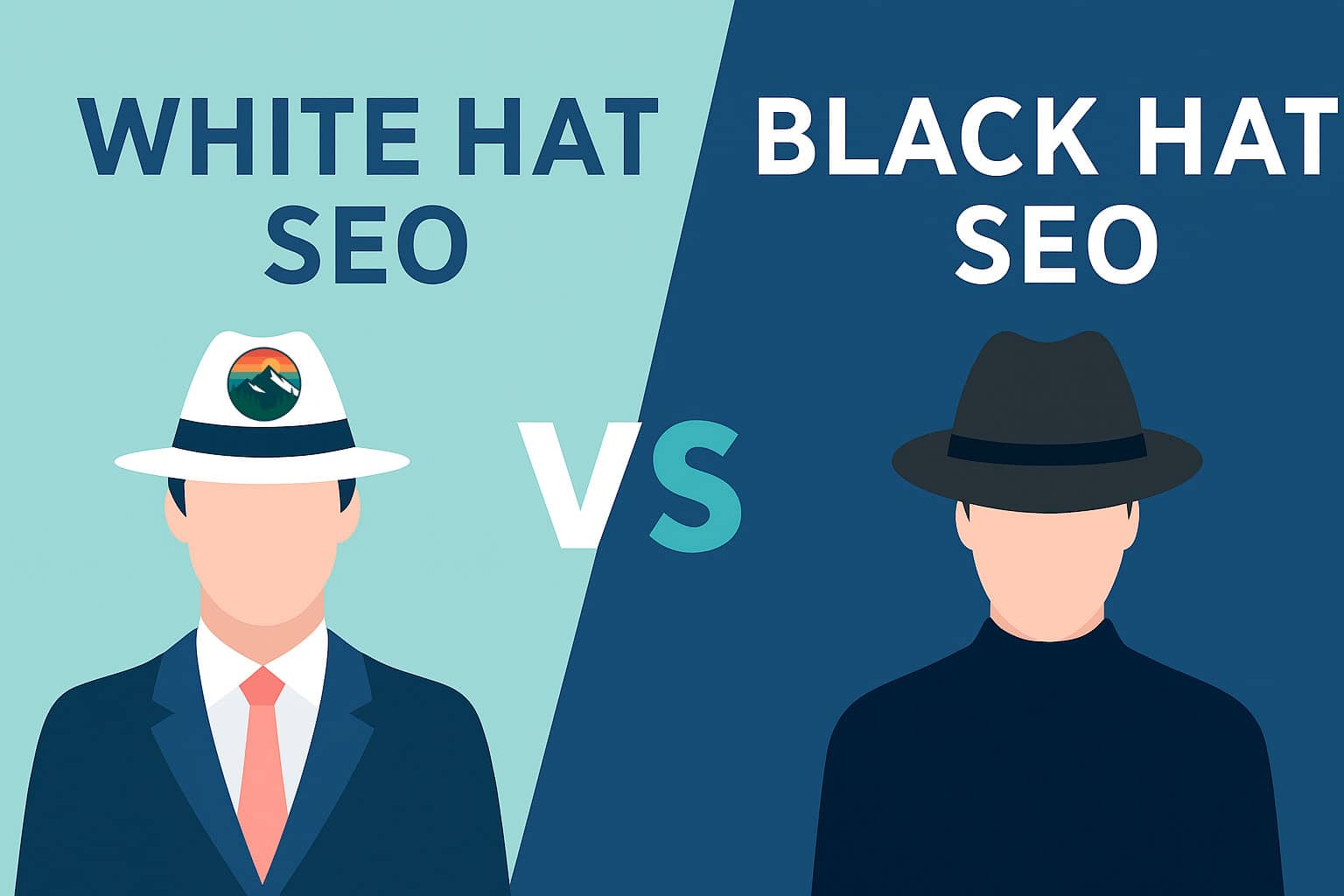White Hat vs Black Hat SEO: Ethical Practices, Techniques, and Google’s Response
In the rapidly evolving digital ecosystem, Search Engine Optimization (SEO) has become one of the most influential forces in determining a website’s visibility, authority, and commercial success. At its core, SEO refers to the set of practices that enhance the ranking of web pages in organic (non-paid) search engine results. However, not all SEO methods are created equal—White Hat SEO and Black Hat SEO represent two opposing approaches that reflect ethical divergence, strategic intent, and risk profiles.
I. Introduction
A. Definition of White Hat and Black Hat SEO
White Hat SEO refers to the use of ethical, user-centric optimization strategies that align explicitly with the rules and quality standards established by search engines like Google. These practices focus on enhancing the user experience, crafting high-quality content, building trustworthy backlinks, and complying with search engine guidelines to achieve long-term, sustainable ranking benefits. It is essential to follow Google’s guidelines to ensure ethical and sustainable SEO practices.
On the other hand, Black Hat SEO encompasses a group of manipulative, deceptive tactics designed to artificially inflate a website’s search ranking by exploiting vulnerabilities in search engine algorithms. Black Hat SEO often seeks to exploit weaknesses in Google’s algorithm to gain unfair ranking advantages. Black Hat techniques deliberately violate search engine policies, frequently prioritizing quick wins over long-term success, user trust, and brand reputation.
B. Google Search Essentials Overview
In 2025, Google Search Essentials—formerly known as Webmaster Guidelines—remains the authoritative standard dictating what constitutes acceptable practices in SEO. The guidelines consist of three primary pillars:
Adhering to Google Search Essentials is vital; even minor or accidental violations can trigger algorithmic demotions or manual actions by the Google Spam Team, resulting in lost revenue, damaged brand trust, or total exclusion from search results.
C. Importance of Ethical SEO Practices
Ethical SEO practices (i.e., White Hat) are foundational to sustainable digital growth. Unethical tactics, such as those employed in Black Hat SEO, are increasingly risky and ineffective due to constant algorithm improvements (including AI-driven tools), regular spam updates, and the ever-rising expectations of users for relevance and trustworthiness in search experiences. Ethical SEO is not just about compliance, but also about building long-term value, cultivating a brand reputation, and ensuring your site thrives in evolving search technologies.
II. Understanding SEO Approaches
A. White Hat SEO
1. Core Principles
At its heart, White Hat SEO is characterized by a devotion to user experience, content quality, and search engine compliance. Core ethical approaches to SEO include white hat SEO techniques, white hat SEO tactics, white hat techniques, white hat tactics, and white hat SEO strategies, all of which focus on sustainable, guideline-compliant optimization. The main principles include:
- Transparency: Practices are open and explainable.
- Value Creation: Content is crafted for users first—not merely to manipulate rankings.
- Compliance: All actions are consistent with Google Search Essentials and industry standards.
- Focus on Trust: Establishing Experience, Expertise, Authoritativeness, and Trustworthiness (E-E-A-T).
2. Focus on User Experience and Content Quality
With algorithms now evaluating UX signals (bounce rate, dwell time, Core Web Vitals) and rewarding substantive, clear answers, White Hat SEO goes beyond technical tweaks—it is about satisfying the user’s search intent better than competitors. Creating high quality, relevant content is fundamental to white hat SEO and user satisfaction, as it aligns with search engine guidelines and enhances the overall experience. Quality is demonstrated by:
- In-depth, well-researched, unique content.
- Responsive, mobile-friendly webpage design.
- Fast-loading pages—proven to increase rankings and engagement.
- Accessible navigation, clear site structure, and minimal intrusive ads.
3. Key Practices
Below are the main techniques and their importance—the hallmark of sustainable SEO and optimizing websites using ethical methods:
- Keyword Research: Identify search phrases that reflect user intent, are relevant, and have achievable competition. Use both broad and long-tail variants to capture a wide spectrum of user needs. When selecting target keywords, ensure the target keyword is integrated naturally to avoid keyword stuffing, which can harm SEO and user experience.
- High-Quality Content Creation: Develop comprehensive, fresh, people-centric content addressing specific user needs. This includes original articles, guides, research, and answers to FAQs.
- Long-Form Content Strategy: Well-structured, in-depth pieces perform best for both users and search engines.
- Rich Snippet Optimization: Proper use of schema markup (structured data) enables enhanced search visibility with ratings, FAQs, how-tos, etc., improving click-through rates.
- Link Building and Source Credibility: Earn backlinks from authoritative, related sites via outreach, networking, and creating “link bait” content. Ethical link building is a core white hat practice, focusing on earning natural backlinks through quality content rather than manipulative tactics.
- Site Performance Optimization: Improve site speed and Core Web Vitals (LCP, FID, CLS)—critical UX/ranking factors.
- Mobile-Friendliness: Ensure seamless experience across all device types; mobile-first indexing is now the default.
- User Experience Enhancement: Intuitive navigation, clear calls to action, and minimal aggressive advertising.
- Technical SEO: Clean code, well-structured URLs, sitemaps, robots.txt, SSL encryption, and error-free crawling. On page optimization—including meta tags, headings, and image alt text—is essential for enhancing website visibility and user experience.
- Social Media Engagement: Amplify content reach and foster credibility, which indirectly supports organic SEO.
A well-implemented White Hat SEO strategy yields stable search visibility, fosters brand trust, and enhances resilience against algorithm changes, as demonstrated by numerous recent case studies and market-leading brands.
B. Black Hat SEO
1. Definition and Origins
Black Hat SEO is shorthand for a set of manipulative, risky strategies that seek to exploit technical loopholes or algorithmic blind spots in search engines. Black hat SEO refers to deceptive practices that violate search engine guidelines. The term originates from Western movies where “black-hatted” outlaws were the villains, and later migrated to computing and cybersecurity to describe unethical actors.
Black hat SEO focuses on using black hat strategies and black hat SEO tactics to trick search engines and mislead search engines. Black hat SEO practices and black hat practices are designed to manipulate search engine rankings by manipulating search engines. Black Hat tactics aim to trick machines instead of genuinely serving users, in clear violation of established policies such as Google’s spam guidelines (now integrated into Search Essentials).
2. Short-Term vs. Long-Term Impacts
Black Hat SEO is often attractive for quick, temporary ranking boosts—especially in hyper-competitive niches or “churn-and-burn” projects. However, the downsides now dramatically outweigh the upsides:
- Short-Term: Temporary ranking spikes and traffic surges.
- Long-Term: Severe risks of penalties (manual actions, de-indexing), loss of all organic traffic, erosion of trust, and sometimes irreparable brand damage. Penalties can result in a site being removed or heavily demoted in Google search results, causing a significant drop or complete loss of search engine rankings. Recent algorithm updates and spam teams drastically reduce the “lifespan” of such tactics.
3. Common Unethical Techniques
| Black Hat Technique | Description | Current Detection/Impact |
|---|---|---|
| Keyword stuffing | Overusing target phrases unnaturally in content, meta tags, alt text. | Easily detected — penalties |
| Hidden content/links | Concealing keywords or links (e.g., same-color text on background, off-screen). | Detected by spiders — penalties |
| Automated comment spam | Posting link-filled comments on blogs, forums, or wikis. | Blocked/flagged quickly |
| Content scraping | Copying content from other sites and passing it off as original. | Panda/SpamBrain — penalties |
| Cloaking | Serving different content to bots than to humans. | Manual actions — penalty |
| Doorway pages | Multiple similar pages targeting different geographies/keywords. | Algorithmic/manual penalty |
| Sneaky redirects | Redirecting users (not search engines) to unrelated or spammy pages. | Manual action — severe |
| Link schemes/PBNs | Buying/selling links, using Private Blog Networks, excessive link exchanges. | Penguin/SpamBrain — penalty |
| Duplicate/spun content | Rewriting or spinning articles using automation. | Detected and devalued |
| Negative SEO | Attempting to harm competitors through black hat tactics, like spammy links. | Ignored or penalized |
Each method listed above is considered a black-hat SEO technique, involving manipulative tactics aimed at deceiving search engines. These practices are no longer sustainable, as Google’s detection capabilities have accelerated, and real-world cases demonstrate the severity and persistence of penalties—even for multinationals such as BMW, Rap Genius, and JCPenney.
C. Gray Hat SEO
1. Definition
Gray Hat SEO occupies the ambiguous space between White and Black Hat, often involving tactics not explicitly forbidden by search engines, but which tread close to the boundaries of their intent and ethics. Grey hat tactics are strategies that fall between white and black hat SEO, carrying a higher risk of penalties compared to white hat techniques and may be detected by search engines as manipulative. These methods may not be penalized immediately but carry considerable risk, especially as guidelines and enforcement become more nuanced.
2. Practices Between White and Black Hat
Classic Gray Hat techniques include:
- Buying expired domains: With strong backlinks and redirecting them to main site to “inherit” link equity.
- Content spinning: Rewriting articles just enough to pass as original, but the quality is typically low.
- Private Blog Networks (PBNs): Creating a network of websites for artificial link-building with more plausible deniability.
- Buying links: Paying for backlinks to manipulate search rankings is often considered black hat SEO, but may sometimes be seen as gray hat when done through sponsored content or genuine partnerships that appear more natural.
- Duplicating content: Copying or mirroring content across different domains is a risky gray hat tactic that can lead to penalties if not handled carefully.
- Sensational/clickbait headlines: Driving engagement but risking high bounce rates or disappointing users.
- Aggressive anchor text optimization: Not outright manipulative, but more contrived than organic link building.
- Link exchanges: Manual, non-scaled cross-linking between agreed websites.
- Over-optimization: Pushing on-page or off-page SEO just enough that it toes the line.
Some gray hat tactics, such as duplicating content or buying links, may be considered black hat SEO if they cross certain boundaries or are used in a manipulative way.
3. Risks and Considerations
Gray Hat strategies may offer short-term gains or fill competitive gaps, especially for startups or in tougher industries, but they’re inherently unstable. Risks include:
- Retroactive penalties: Google’s evolving policies and AI-driven systems can penalize tactics that were once tolerated.
- Reputation damage: Discovery by users or competitors risks public shaming and trust loss.
- Unpredictable ROI: Algorithm or policy changes can rapidly transform a “gray” practice into a black-hat penalty trap.
If long-term stability, strong brand equity, or Google compliance is the goal, the safest path is to avoid Gray (and Black) tactics and invest in White Hat principles.
III. Google’s Detection and Response to Web Spam
A. Spam-Targeting Algorithm Updates
Google’s history of spam-fighting technology is deep and continually evolving. Major algorithm updates and systems dedicated to identifying and penalizing spam include:
1. Google Panda
- Launched: 2011 (and continuously updated through 2025 as part of core algorithms).
- Impact: Penalizes thin, duplicate, or low-quality content on site level, including sites with duplicate content that appears across different websites.
- Purpose: Reward unique, useful content and filter out content farms and “scraped” pages.
2. Google Penguin
- Launched: 2012 (with periodic real-time integration).
- Impact: Targets manipulative link practices, such as purchased links, spammy anchor text, link farms, and PBNs.
- Purpose: Restore integrity to Google’s link graph by rewarding natural, earned links and penalizing link schemes.
3. SpamBrain
- Launched: Announced 2022, continuously updated; SpamBrain is a machine learning/AI-driven system that identifies evolving spam patterns across hundreds of signals.
- Impact: Amplifies detection speed and scope, targeting not just traditional spam, but also scaled content abuse, doorway pages, and AI-generated low-value pages.
Recent spam updates, such as those in August 2025, demonstrated the increasing precision and scale of Google’s efforts—sites affected by these updates often experienced a significant decline in traffic within hours to days, and many never recovered without a complete shift to White Hat practices and a clean reconsideration request.
B. Quality-Rewarding Algorithm Updates
While spam updates enforce penalties, other core updates reward exemplary SEO practices and sites that improve search engine rankings through ethical strategies:
- Helpful Content Update (HCU): Prioritizes people-first, experience-based content, devaluing AI-generated, thin, or over-optimized material.
- Core Web Vitals & Page Experience: Speed, interactivity, and layout stability are explicit ranking factors, signaling the elevated importance of user experience.
- E-E-A-T (Experience, Expertise, Authoritativeness, Trustworthiness): Google’s quality raters and algorithms increasingly reward brands and individuals who can demonstrate clear credentials and expertise, which has a direct impact on search engine ranking.
C. Google Spam Team
Beyond algorithms, Google employs a dedicated human team—the Spam Team—to enforce policies through manual reviews, spot checks, and penalty assignments. They handle “manual actions,” issue notifications via Google Search Console, and process reconsideration requests when webmasters attempt to rectify violations.
IV. Consequences of Black Hat SEO
A. Search Engine Penalties
1. Manual Actions
A “manual action” occurs when a Google reviewer flags a site for violating Search Essentials, resulting in one or more pages, or the entire site, being demoted or removed from search results. Webmasters receive explicit notification in Search Console, with details about affected areas, and can submit reconsideration requests only after rectifying all issues.
2. Ranking Reductions
Algorithmic penalties can drop rankings virtually overnight for targeted queries or specific sections of a site. In some cases, organic traffic can fall by 70–90% within days. Algorithm penalties are often more challenging to diagnose and may not include explicit messaging.
3. Complete Site Bans
The most severe cases—pure spam, persistent cloaking, or link schemes—can result in entire domains being de-indexed. Sites may never recover, especially if the domain history is irreparably tainted.
B. Reputation Damage
Users, industry peers, and potential partners increasingly shun brands associated with unethical tactics, further harming customer trust, press coverage, and reputation. For large brands, public penalty cases can garner widespread negative attention (as seen with JCPenney, Rap Genius, BMW, etc.).
C. Backlink Profile Degradation
Being penalized or delisted strips value from previously earned backlinks. In fact, ongoing spammy link practices can “toxify” your link profile, undermining trust with both Google and referral users. Disavowing links and rebuilding a clean reputation can require months or even years, if recovery is possible at all.
D. Ecosystem Integrity Disruption
Black Hat SEO pollutes search results, devalues legitimate content, and forces algorithmic adjustments that may have collateral negative impact on otherwise-compliant websites. Negative SEO (trying to harm competitors) is increasingly ineffective as Google has improved its ability to ignore malicious patterns, but it is ethically problematic and destabilizes trust in web ecosystems.
V. Avoiding Black Hat SEO Techniques
A. Identifying Red Flags
Recognize warning signs in your own SEO practices and those of agencies, consultants, or outsourced vendors:
- Promised “guaranteed” ranking in X days/weeks.
- Opaque link-building or “network” strategies.
- Low-quality content at scale, or “spun” articles that lack coherence.
- Pressure to implement hidden elements, doorway pages, or artificial redirects.
- Large numbers of sudden backlinks from irrelevant or low-authority sources.
B. Importance of Transparency
Ethical SEO is explainable, understandable, and justifiable to any business partner, Google employee, or peer. If you would be embarrassed to present your method publicly, it’s suspect.
C. Reviewing Outsourced Content
Always check outsourced content for:
- Originality (plagiarism/duplicate checks).
- Alignment with brand voice and audience intent.
- Natural keyword use—avoid robotic repetition.
- Factual accuracy and authorial credibility.
D. Adhering to Google’s Guidelines
- Regularly review the Google Search Essentials.
- Monitor Search Console messages for manual actions or guidance.
- Prioritize compliance, user experience, and long-term value over shortcuts or rapid, unexplainable ranking leaps.
VI. Comparative Analysis
| Dimension | White Hat SEO | Black Hat SEO |
|---|---|---|
| Ethics | Fully complies with Search Essentials and ethical standards | Explicitly violates policies, manipulates algorithms |
| Content Quality | Original, thorough, people-friendly, readable | Often thin, spun, duplicate, or stuffed with keywords |
| User Experience | Prioritizes navigation, speed, mobile optimization, accessibility | Degrades with hidden text, intrusive ads, sneaky redirects, poor design |
| Links | Earned from reputable, relevant sources | Bought, exchanged, automated, or PBN-based |
| Ranking Impact | Slow, steady, sustainable growth; resilient to algorithm changes | Rapid, but ephemeral spikes; likely to collapse with penalties |
| Risk Profile | Minimal; rarely penalized, quick to recover from honest mistakes | High; subject to manual actions, de-indexing, persistent bans |
| Trust & Reputation | Builds brand authority and user loyalty | Damages brand, alienates users, press, and partners |
| Compliance | Proactively aligns with policy updates | Retroactively punished with each policy/algorithm change |
| Longevity | Enduring; supports business stability | Short-lived; churn-and-burn cycles |
A. Ethical Considerations
White Hat SEO aligns with both the letter and the spirit of Google’s Search Essentials—positively influencing broader web accessibility, content quality, and digital integrity. Black and, to a lesser extent, Gray Hat SEO undermine trust, fuel arms-race dynamics with search engines, and can create negative-sum outcomes for all internet users.
B. Search Ranking Impact
While Black Hat tactics can provide “overnight” success, Google’s detection has rendered most of these simply unsustainable in the medium/long term. Penalties are now severe and more swiftly enacted than in the past. ROI for White Hat SEO is slower but compounding, with much higher resilience to fluctuating algorithm criteria.
C. Risks and Consequences
Investing in Black Hat approaches almost guarantees eventual penalties, erasure of link equity, possible domain bans, and enduring reputational harm. White Hat investments, conversely, are future-proofed and reinforce each other through compounded trust and earned authority.
D. Long-Term vs. Short-Term Results
Long-term business goals demand strategies built on sustainable foundations. As illustrated by recent case studies in 2025, companies relying on manipulative tactics may see weeks or even months of increased traffic, only to lose all organic presence overnight following a single spam update or manual review. By contrast, those adhering to White Hat principles have not only survived but grown stronger, despite seismic changes in Google’s algorithms and the dominance of AI in search analysis and summary features.
E. User Experience Considerations
User experience is now a core part of the search algorithm, with Core Web Vitals, responsive design, clear navigation, and accessible content being rewarded directly. Black Hat tactics create poor experiences, higher bounce rates, lower dwell times, and reduced conversions, all of which are now measurable by Google’s sophisticated AI systems.
VII. Conclusion
A. Importance of Ethical SEO Practices
| Dimension | White Hat SEO | Black Hat SEO |
|---|---|---|
| Ethics | Fully complies with Search Essentials and ethical standards | Explicitly violates policies, manipulates algorithms |
| Content Quality | Original, thorough, people-friendly, readable | Often thin, spun, duplicate, or stuffed with keywords |
| User Experience | Prioritizes navigation, speed, mobile optimization, accessibility | Degrades with hidden text, intrusive ads, sneaky redirects, poor design |
| Links | Earned from reputable, relevant sources | Bought, exchanged, automated, or PBN-based |
| Ranking Impact | Slow, steady, sustainable growth; resilient to algorithm changes | Rapid, but ephemeral spikes; likely to collapse with penalties |
| Risk Profile | Minimal; rarely penalized, quick to recover from honest mistakes | High; subject to manual actions, de-indexing, persistent bans |
| Trust & Reputation | Builds brand authority and user loyalty | Damages brand, alienates users, press, and partners |
| Compliance | Proactively aligns with policy updates | Retroactively punished with each policy/algorithm change |
| Longevity | Enduring; supports business stability | Short-lived; churn-and-burn cycles |
Final Best Practices for Sustainable SEO
To ensure ongoing SEO success, adhere to the following principles:
- Follow Google Search Essentials: Regularly review updates, and align all practices accordingly.
- Publish high-quality, original content: Leverage topic clusters, semantic search, and deep expertise.
- Optimize for Core Web Vitals and mobile experience: Monitor site speed, interactivity, and visual stability.
- Earn, don’t buy or fabricate, backlinks: Prioritize authority, relevance, and organic growth.
- Leverage structured data and rich snippets: Enhance search presence ethically and improve CTR.
- Continuously audit and analyze: Use tools like Google Search Console, Analytics, and third-party SEO platforms to track visibility, engagement, and compliance.
- Stay up-to-date on algorithm changes and industry trends: Invest in ongoing education, collaboration, and technical refinement.
As Google’s AI-driven algorithms and spam-fighting teams continue to evolve, ethical, user-centric SEO is no longer just preferable—it is the only rational, sustainable choice for organizations that value their long-term visibility, trust, and prosperity.
Further Reading & Resources
This guide is based on analysis and synthesis of up-to-date insights and a wide range of authoritative sources to inform SEO professionals, businesses, and stakeholders about the evolving landscape of ethical optimization practices. In 2025 and beyond, sustainable SEO belongs to those who earn their place at the top of the search results through expertise, transparency, and an unwavering focus on quality.




